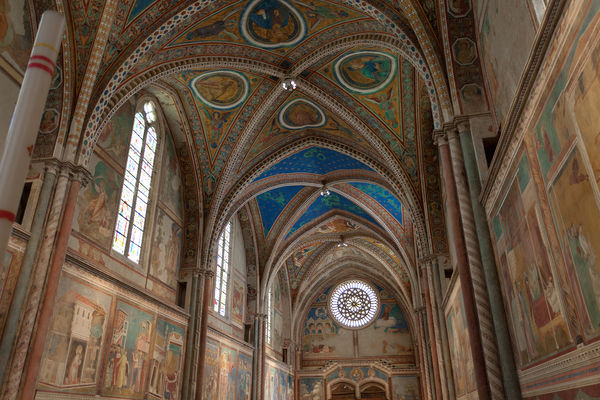Finding Peace and Faith in Assisi
By Rick Steves

Located in the hills of central Italy, is Assisi, the hometown of St. Francis. It's where he was born, lived, worked, and died. Today tourists flock to this town, which sits atop a hill just outside of Tuscany in neighboring Umbria, to visit the basilica that's dedicated to him and to celebrate his teachings: chastity, obedience, harmony, and a beautiful promise of your reward in heaven.
Francis taught by example, living without worldly goods and aiming to love all creation. He and his "brothers" (fratelli, or friars) slept in fields, begged for food, and exuded the joy of nonmaterialism. Known as the "Jugglers of God," as peasants have called Franciscan friars for eight centuries, they modeled themselves after French troubadours (jongleurs, or jugglers) who roved the countryside singing and telling stories and jokes.
Perched on a ridge at the bottom of the old town, the grand Basilica of St. Francis is one of the spiritual and artistic highlights of Western civilization. Built between 1228 and 1253, the church has three parts: the upper basilica, the lower basilica, and the saint's tomb. In the lower basilica, a fresco of the Crucifixion by Giotto, a follower of St. Francis himself, was considered radical at the time for its unprecedented realism and its depiction of holy people expressing emotion. Below the lower basilica is the tomb, with a humble elegance and beauty befitting the saint's message.
The upper basilica — the first Gothic church in Italy — is slathered with frescoes by Giotto and his followers, showing 28 scenes from Francis' life. One scene depicts a nearly naked Francis — the rich kid tossing his fancy clothes to his father — befuddling high society by trading a life of power and luxury for one of simplicity and poverty. Perhaps the most endearing scene shows Francis preaching to the birds, who represent the diverse flock of humanity and nature, all created by God and worthy of love.
Every time I'm here, I learn something. On my last visit, a friar named Daniel helped me clarify some points: to call St. Francis a monk is technically wrong. Monks live in solitude in a monastery — it's just them and God. Franciscans are friars — their calling is to be with people as brothers. And they stay in convents, which are not just for women (and monasteries are not just for men). It's all about whether you're social or solitary — like the words "convene" and "monologue," whose roots they share. As always, I left inspired by the friars' gentle and loving approach to life. In a hyphenated word, they are Christ-like.
The story of St. Francis starts in the Basilica of Maria degli Angeli, located in the modern town in the valley below Assisi. It's here that Francis restored a small chapel and established the Franciscan order. Centuries later, to accommodate the many pilgrims wanting to pay homage to St. Francis, a grand church was built surrounding the chapel, which now sits directly under the dome. (I wonder what humble Francis would think of the huge church built over his tiny chapel?) Nearby is the small cell where Francis died.
Especially in a stony and historic town like Assisi, I enjoy spending the night so I can take in the ambience after the day-trippers disperse. There's history everywhere, such as the Temple of Minerva — the centerpiece of Roman Assisi 2,000 years ago. I love hanging out in what was the Roman forum (today's main square), marveling at the beautiful fluting on the temple's Corinthian columns.
Walking through town, you may also see some crèches, which are extremely popular here. It's said that St. Francis, a master at teaching Bible lessons with clever props, created the first Nativity scene to help people relate to the Christmas message more vividly. Ever since then, the Baby Jesus has been shown on his day of birth in a humble setting, in local scenes that have not a hint of Bethlehem — an Italian setting for Italian viewers (or an Arctic scene for Eskimos) — to connect more intimately with the story of the Nativity.
In Assisi, my favorite ritual is to sit quietly on the rampart of the medieval fortress high above town. I look down at the basilica dedicated to the saint, then into the valley at the church where Francis and his "Jugglers of God" started the Franciscan order. Hearing the same birdsong that inspired Francis, and tasting the same simple bread, cheese, and wine of Umbria that sustained him, I calm my 21st-century soul and ponder the message of a saint who made the teaching of Jesus so accessible.

